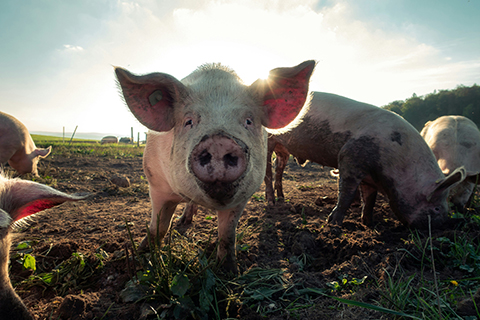Seeking the sweet spot to beat a pig parasite
Outbreaks of the nematode Trichuris suis, also known as porcine whipworm, can be costly for pig farmers and inflict suffering on animals with severe infections. This worm reproduces in pigs’ digestive tracts, causing dehydration, malnourishment and sometimes death. Understanding how a pig's immune system reacts to T. suis is an important step toward developing better strategies for helping animals to clear it.
Iain B.H. Wilson’s lab at the Universität für Bodenkultur in Vienna, in collaboration with Richard Cummings’ lab at Harvard Medical School, tackled the question of how the pig immune system recognizes sugar molecules, or glycans, found on T. suis proteins. The group recently reported their findings in the journal Molecular & Cellular Proteomics. Lead author Barbara Eckmair, along with co-author Katharina Paschinger and Wilson walked us through their process, their findings and the importance of this study.

The group extracted glycans from worms and then separated different types of glycans using high-performance liquid chromatography, a technique that isolates compounds within a mixture based on how easily they separate due to their size and structure. They then created arrays of spots made up of the separated glycans. Using these arrays, they tested several innate immune system proteins, as well as immunoglobulin G and M, or IgG and IgM, antibodiesfrom T. suis–infected pigs, to see how well they bound to each glycan spot.
“Some large molecular-weight glycans seemed to have the bulk of the response to the antisera,” Wilson said. “So that left the question as to what the exact structures were.”
They found that many fucose residues were common, as well as a zwitterion called phosphorylcholine, and up to eight phosphorylcholine residues could decorate some of the glycans.
“Lots of other nematodes have phosphorylcholine on their N-glycans,” he said, “and these are very often associated with immune system downregulation.”
However, this was the first time such large structures had been found in T. suis.
Wilson said this research is especially impactful for organic farming because animals raised this way receive fewer antiparasitic drugs and are at higher risk of worm infections. Earlier studies suggest that vaccination against these parasites is an attractive potential strategy.
“There are indications from Haemonchus, which is a sheep parasite, that the glycans would be important for making the vaccine," Wilson said.
When asked about the next steps for this research, co-author Paschinger said that determining which glycans are bound by IgE, an antibody that plays a key role in the immune response to parasites, is an important question to answer.
Eckmair, the paper’s lead author, explained that IgE binding could not be addressed in this study because the reagents needed to test pig IgE binding are difficult to procure, but she said future experiments could tackle this and many other questions.
“Of course, there is more immunological work that we could do, because we still have some of the arrays left,” Eckmair said. “This was really a lucky case because we have so much material that we could test.”
This research is not only a step toward understanding the pig immune response to T. suis; by helping researchers understand the immune response to glycans found in Trichuris trichiura, the human whipworm, it might lead to medical advances for humans as well.
Enjoy reading ASBMB Today?
Become a member to receive the print edition four times a year and the digital edition monthly.
Learn moreGet the latest from ASBMB Today
Enter your email address, and we’ll send you a weekly email with recent articles, interviews and more.
Latest in Science
Science highlights or most popular articles

Targeting Toxoplasma parasites and their protein accomplices
Researchers identify that a Toxoplasma gondii enzyme drives parasite's survival. Read more about this recent study from the Journal of Lipid Research.

Scavenger protein receptor aids the transport of lipoproteins
Scientists elucidated how two major splice variants of scavenger receptors affect cellular localization in endothelial cells. Read more about this recent study from the Journal of Lipid Research.

Fat cells are a culprit in osteoporosis
Scientists reveal that lipid transfer from bone marrow adipocytes to osteoblasts impairs bone formation by downregulating osteogenic proteins and inducing ferroptosis. Read more about this recent study from the Journal of Lipid Research.

Unraveling oncogenesis: What makes cancer tick?
Learn about the ASBMB 2025 symposium on oncogenic hubs: chromatin regulatory and transcriptional complexes in cancer.

Exploring lipid metabolism: A journey through time and innovation
Recent lipid metabolism research has unveiled critical insights into lipid–protein interactions, offering potential therapeutic targets for metabolic and neurodegenerative diseases. Check out the latest in lipid science at the ASBMB annual meeting.

Melissa Moore to speak at ASBMB 2025
Richard Silverman and Melissa Moore are the featured speakers at the ASBMB annual meeting to be held April 12-15 in Chicago.

